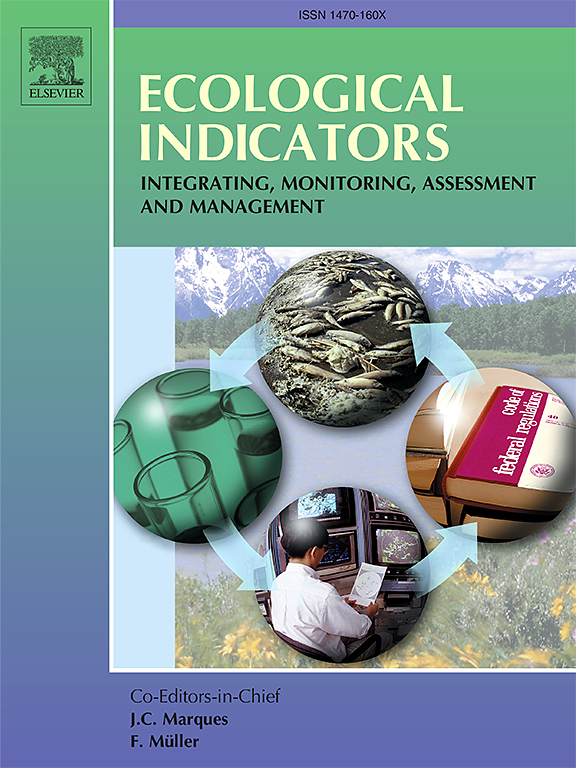黑桤木可以增强河岸缓冲,缓解松林对上游大型无脊椎动物食物网的影响
IF 7
2区 环境科学与生态学
Q1 ENVIRONMENTAL SCIENCES
引用次数: 0
摘要
在过去的一个世纪里,旱地经历了重大的景观变化。传统作物和牧场的放弃导致了广泛的针叶树造林计划的发展,这些计划往往缺乏生态良好的导向,引起了人们对其对接收生态系统潜在后果的担忧。森林溪流严重依赖陆生有机碳的输入,因此特别容易受到人类驱动的集水区和河岸森林变化的影响。不确定的一点是,河岸地带现有的落叶树林是否可以缓冲水源食物网,使其免受植树造林对周围景观的影响。利用碳氮稳定同位素研究了固氮黑桤木在河岸带的存在是否会改变松林对源流大型无脊椎动物食物网的影响。我们观察到碎纸机对凋落叶的持续消耗,但对所有大型无脊椎动物功能摄食群的原生支持比最初预期的更重要,特别是在没有桤木的情况下。此外,我们还发现了冬季河岸桤木溪流中食物链延长的潜在趋势。总的来说,我们的研究结果表明,通过减少底栖动物消费者和资源之间普遍存在的营养不平衡,河岸桤木可以增强其他阔叶物种发挥的缓冲作用,这可能转化为更长的食物链。这些发现强调了河岸植被的关键作用,特别是像黑桤木这样的落叶物种,在维持绿化景观的源头生态系统完整性方面。将河岸植被管理纳入造林规划可以提高河流食物网的稳定性,支持更平衡的水生生态系统。本文章由计算机程序翻译,如有差异,请以英文原文为准。
Black alder may enhance riparian buffer mitigation of pine-plantation effects on macroinvertebrate food webs in headwater streams
Over the past century, drylands have undergone significant landscape transformations. Abandonment of traditional crops and pastures led to development of extensive afforestation programs with conifers, which often lacked an ecologically sound orientation, raising concerns on their potential consequences on recipient ecosystems. Forest streams heavily rely on inputs of terrestrial organic carbon and thus are particularly vulnerable to human-driven changes in catchment and riparian forests. One point of uncertainty is whether existing stands of deciduous trees in the riparian zone may buffer headwater stream food webs from the impacts of afforestation on the surrounding landscape. We used stable isotopes of carbon and nitrogen to investigate whether the presence of the nitrogen-fixing black alder in the riparian zone alters the impacts of pine plantations on macroinvertebrate food webs of headwater streams. We observed a consistent consumption of leaf litter by shredders, but a higher importance of autochthonous support to all macroinvertebrate functional feeding groups than initially expected, especially in absence of alder. In addition, we discerned a potential trend toward a food chain lengthening at streams holding riparian alder in winter. Overall, our results indicate that riparian alder can enhance the buffer effect exerted by other broadleaf species through a reduction of the usual wide nutritional imbalance existing between benthic consumers and resources, which may translate into longer food chains. These findings highlight the critical role of riparian vegetation, particularly deciduous species like black alder, in maintaining headwater stream ecosystem integrity within afforested landscapes. Incorporating riparian vegetation management into afforestation planning can enhance stream food-web stability and support more balanced aquatic ecosystems.
求助全文
通过发布文献求助,成功后即可免费获取论文全文。
去求助
来源期刊

Ecological Indicators
环境科学-环境科学
CiteScore
11.80
自引率
8.70%
发文量
1163
审稿时长
78 days
期刊介绍:
The ultimate aim of Ecological Indicators is to integrate the monitoring and assessment of ecological and environmental indicators with management practices. The journal provides a forum for the discussion of the applied scientific development and review of traditional indicator approaches as well as for theoretical, modelling and quantitative applications such as index development. Research into the following areas will be published.
• All aspects of ecological and environmental indicators and indices.
• New indicators, and new approaches and methods for indicator development, testing and use.
• Development and modelling of indices, e.g. application of indicator suites across multiple scales and resources.
• Analysis and research of resource, system- and scale-specific indicators.
• Methods for integration of social and other valuation metrics for the production of scientifically rigorous and politically-relevant assessments using indicator-based monitoring and assessment programs.
• How research indicators can be transformed into direct application for management purposes.
• Broader assessment objectives and methods, e.g. biodiversity, biological integrity, and sustainability, through the use of indicators.
• Resource-specific indicators such as landscape, agroecosystems, forests, wetlands, etc.
 求助内容:
求助内容: 应助结果提醒方式:
应助结果提醒方式:


